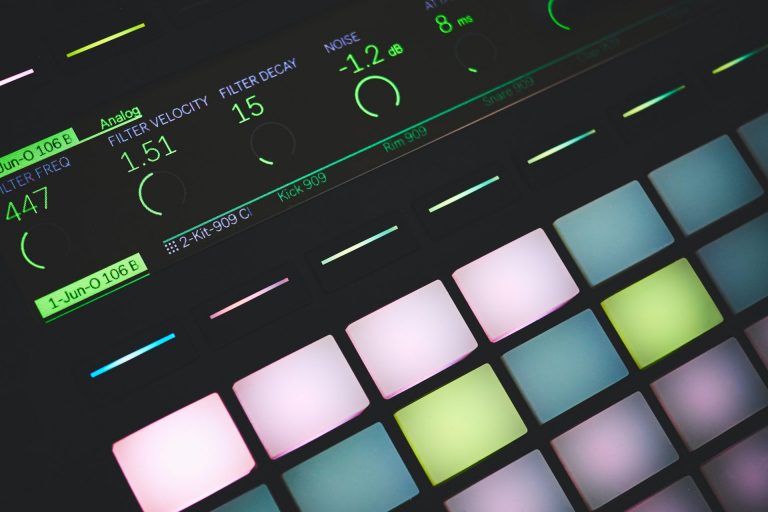
Beat Lab Health Series: How to Create a Solid (and Healthy!) Workflow
With the morphing of the music industry, the position of the music producer has become multi-faceted and ever-growing in responsibilities. Today’s music producer needs to understand music production, business, and marketing in order to survive in the scene.
Many producers on a tight budget have to do the work of a manager, promoter, label, and PR agent; some tasks include creating album artwork, designing merch, distributing music to streaming services, and getting in touch with playlist curators and venues. These are all tasks that can take up a lot of time and energy.
Until you have the money and circle to delegate these tasks, it is up to you to handle them. To keep up with all this work, it is imperative that you utilize your time as efficiently as possible. Doing it all yourself can become overwhelming and exhausting.
Today’s post covers practicing workflow tactics to increase efficiency, without losing sleep or sanity.
[su_divider top=”no”]
Make Goals and a Plan

Think about when you begin producing a track. What do you need to do? Break your process down into steps.
The first step is arranging your track. After your arrangement is complete, the next step is mixing your track. The final step is mastering it (or sending it to a mastering engineer).
Create a realistic timeline for these steps and set deadlines to keep yourself accountable; otherwise, it can be very easy to never finish a song. Write a list of the steps with their deadlines. Keep the list somewhere you look often: make it your phone or laptop wallpaper. Tell people about your deadlines and have them hold you accountable, too.
If you plan on delegating any tasks, give a deadline to those who are doing the task(s).
Part of creating a realistic timeline is to give yourself enough space between projects and phases in each project. For example, when you finish an album, give yourself enough time to send songs into playlist submission services to get added to popular playlists (if that interests you, of course). The recommended time to send albums to blogs, playlist services, and the like, is at least a month.
[su_divider top=”yes”]
Take Notes

This is an extension of planning and setting goals. Taking notes will save you a lot of mental space and stress.
When you discover a useful production technique or learn an indispensable nugget of knowledge, add it to a list with others. If you ever forget, you can just find it using the list.
If there is something that needs to be added, adjusted, or removed from an arrangement that you do not have time to address, set a marker at that point in the arrangement and rename the marker with a detailed note of what needs to be done. This helps you to avoid slowdowns and allows you to move on to a new task— especially if you have multiple deadlines to meet.
Keep a daily planner and write down when you will address these tasks.
[su_divider top=”yes”]
Take Breaks

Producing for hours on end can feel exhilarating— especially if you’re getting a lot done. While this approach is practiced by many, it isn’t the healthiest method. Working tirelessly can cause strain on the body, mind and spirit, which can lead to burning out, or even hazardous, stress-related complications.
Taking breaks is vital. Breaks are the key to keeping the body— and mind— fresh. Taking breaks allows you to regain awareness of your body, so that you can relax your muscles and regain your energy. If you find yourself hitting a wall and feel your motivation beginning to dissipate, don’t push any further. Take five minutes to stretch (link to https://beatlabacademy.com/beat-lab-health-series-stretches-for-producers-musicians-and-everyone/).
Think about watching a professional sport. Professional athletes give all they can while they play, but they make sure to take breaks.
If you don’t already, look into using the Pomodoro technique. https://en.wikipedia.org/wiki/Pomodoro_Technique
When you take a break, it’s best to step away from what you’re doing and rest. Spend a moment in silence. Take a walk. Get some fresh air. Practice mindful breathing.
[su_divider top=”yes”]
Organize Your Samples Library

For a number of music producers, samples are their instrument of choice. With the upsurge of mobile music production, sampling has become the status quo among producers. Since samples are such an integral part of making music, it is extremely important to clean up and maintain sample libraries to provide clear paths that are easy to navigate.
Put your favorite samples in a folder and make the folder easily accessible in your DAW.
Depending on the DAW you use, there is a chance that you have a lot of samples that came with your DAW when you downloaded it. While having choices is great, having too many is detrimental. Save yourself the pain of sifting through tons of samples that will never have practical use in your tracks; delete unnecessary samples.
Make sure to work this into your weekly schedule. Allocate some time (the amount depends on the state of your library) per week to organize your samples.
[su_divider top=”yes”]
Save Presets

This will save a lot of time in the long run. When you create your own Instrument Racks, Audio Effect Racks, and MIDI Effect Racks in Ableton (or your DAW of choice, if possible to do so), make sure to save them as presets.
Rather than having to recreate a preset from scratch, saving a preset allows you to load it from your User Library. This is especially handy for very complex and tediously-built racks. Many third-party VSTs have the option of saving presets within the VST, which is very convenient.
Hopefully, these tricks help you work with the speed and precision required to propel your production to new heights!
We would love to hear your production techniques! Please feel free to comment below!
[su_divider top=”yes”]
Looking to Learn Even More?
Further your production while maintaining social distancing with Beat Lab’s Online Certification program!
[su_divider top=”yes”]
Recommended Modules
[su_row]
[su_column size=”1/3″] [/su_column]
[/su_column]
[su_column size=”1/3″] [/su_column]
[/su_column]
[su_column size=”1/3″] [/su_column]
[/su_column]
[/su_row]









0 responses on "Beat Lab Health Series: How to Create a Solid (and Healthy!) Workflow"